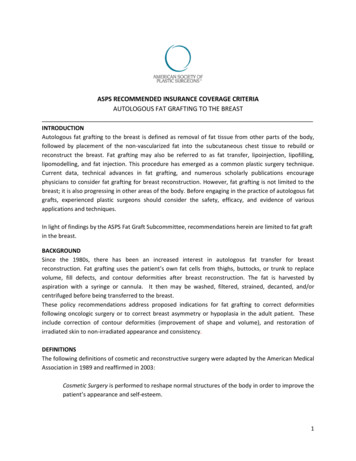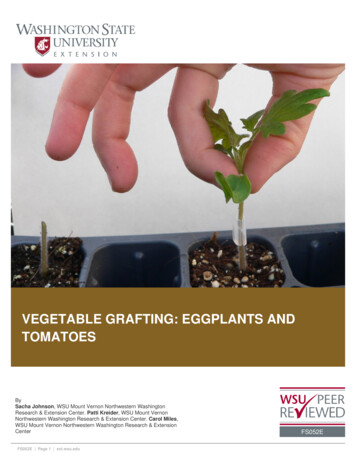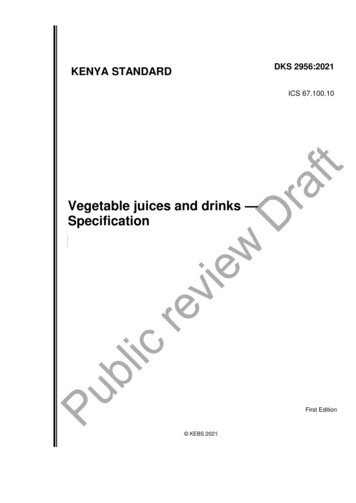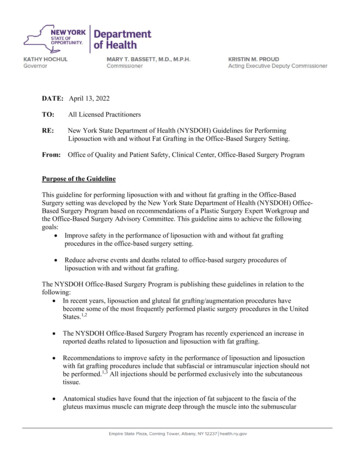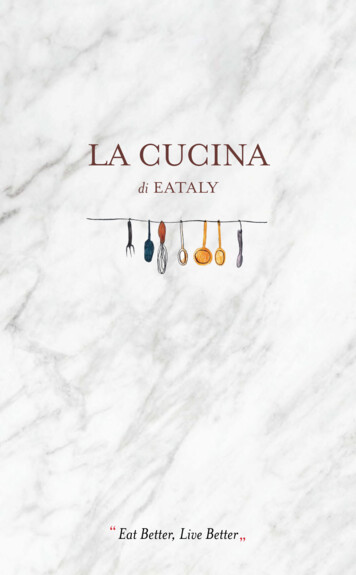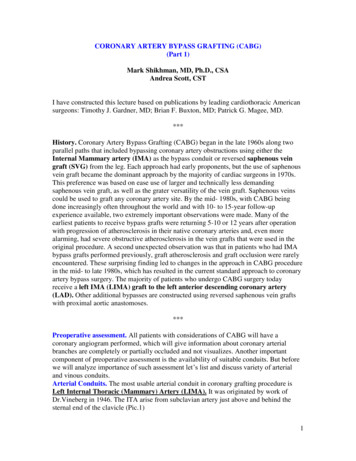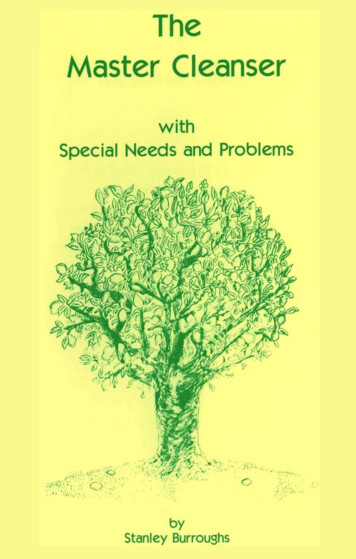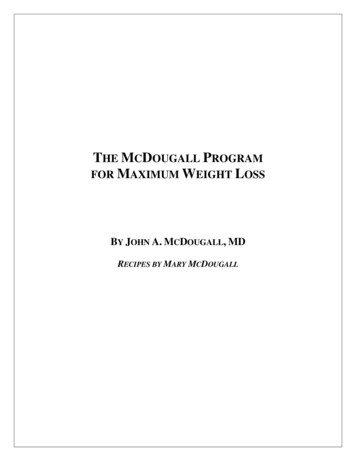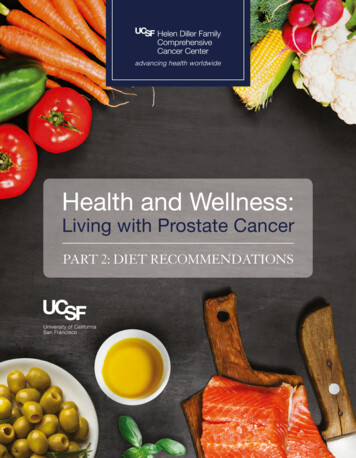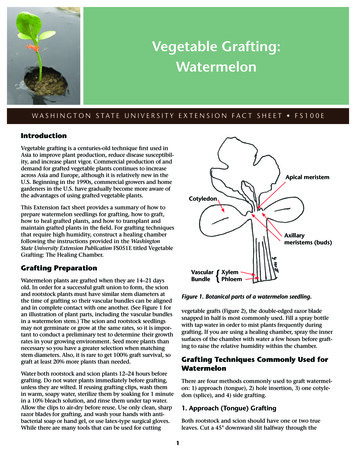
Transcription
Vegetable Grafting:WatermelonWA S H I N G T O N S TAT E U N I V E R S I T Y E X T E N S I O N FA C T S H E E T F S 1 0 0 EIntroductionVegetable grafting is a centuries-old technique first used inAsia to improve plant production, reduce disease susceptibility, and increase plant vigor. Commercial production of anddemand for grafted vegetable plants continues to increaseacross Asia and Europe, although it is relatively new in theU.S. Beginning in the 1990s, commercial growers and homegardeners in the U.S. have gradually become more aware ofthe advantages of using grafted vegetable plants.Apical meristemCotyledonThis Extension fact sheet provides a summary of how toprepare watermelon seedlings for grafting, how to graft,how to heal grafted plants, and how to transplant andmaintain grafted plants in the field. For grafting techniquesthat require high humidity, construct a healing chamberfollowing the instructions provided in the WashingtonState University Extension Publication FS051E titled VegetableGrafting: The Healing Chamber.Axillarymeristems (buds)Grafting PreparationVascularBundleWatermelon plants are grafted when they are 14–21 daysold. In order for a successful graft union to form, the scionand rootstock plants must have similar stem diameters atthe time of grafting so their vascular bundles can be alignedand in complete contact with one another. (See Figure 1 foran illustration of plant parts, including the vascular bundlesin a watermelon stem.) The scion and rootstock seedlingsmay not germinate or grow at the same rates, so it is important to conduct a preliminary test to determine their growthrates in your growing environment. Seed more plants thannecessary so you have a greater selection when matchingstem diameters. Also, it is rare to get 100% graft survival, sograft at least 20% more plants than needed.{ XylemPhloemFigure 1. Botanical parts of a watermelon seedling.vegetable grafts (Figure 2), the double-edged razor bladesnapped in half is most commonly used. Fill a spray bottlewith tap water in order to mist plants frequently duringgrafting. If you are using a healing chamber, spray the innersurfaces of the chamber with water a few hours before grafting to raise the relative humidity within the chamber.Grafting Techniques Commonly Used forWatermelonWater both rootstock and scion plants 12–24 hours beforegrafting. Do not water plants immediately before grafting,unless they are wilted. If reusing grafting clips, wash themin warm, soapy water, sterilize them by soaking for 1 minutein a 10% bleach solution, and rinse them under tap water.Allow the clips to air-dry before reuse. Use only clean, sharprazor blades for grafting, and wash your hands with antibacterial soap or hand gel, or use latex-type surgical gloves.While there are many tools that can be used for cuttingThere are four methods commonly used to graft watermelon: 1) approach (tongue), 2) hole insertion, 3) one cotyledon (splice), and 4) side grafting.1. Approach (Tongue) GraftingBoth rootstock and scion should have one or two trueleaves. Cut a 45 downward slit halfway through the1
ABFigure 2. Supplies commonly used for grafting.rootstock stem below the cotyledons, and cut an identically angled upward slit in the scion stem (Figures 3A and3B). The angle and location of the cuts must be relativelyprecise so the scion can be placed on top of the rootstock.Bring the two cut stems together so they overlap (Figure 3C), then attach a clip or securely wrap the joinedstems in plastic wrap, foil, or parafilm (Figure 3D). Figure 4shows this grafting technique with actual plants. Placethe joined plant in a transplant tray or small pot. Mistthe plant with water and place it on a greenhouse bench.Water the plant as needed. Cut off the top of the rootstock5 days after grafting. Wait 7 days, and then cut off the bottom portion of the scion.CAdvantages: A relatively simple technique. A grafting clip is not essential. A high humidity and low light environment is notrequired for successful healing of the graft union; anormal greenhouse environment is sufficient. There is no shoot regrowth from the rootstock.Figure 3. Approach grafting method.Disadvantages: Figure 4. Approach grafting method.2Requires severing of the rootstock top and thescion bottom after the graft union has healed.D
2. Hole Insertion GraftingRootstock seedlings should have one small true leaf, andscion seedlings should have one or two true leaves. Witha pointed probe, remove the true leaf, the apical meristem(undifferentiated cells), and the axillary buds from thetopmost growing point of the rootstock plant (refer backto Figure 1 for location of plant parts). It is important toremove all of the apical meristem and the axillary budsto prevent future shoot growth of the rootstock. Use theprobe to create a hole in the top of the rootstock wherethe tissue was removed (Figure 5A). Cut the scion belowthe cotyledons at a 45 angle on two sides to form a wedge(Figure 5B) and insert it into the rootstock (Figure 5C). Figure 6 shows this grafting technique with actual plants. Mistwith water and place in healing chamber.Rootstock (A)Advantages: A grafting clip is not essential. There is no trimming of unwanted plant parts afterhealing of the graft union. Tends to have a high success rate.Scion (B)Disadvantages: Requires slightly more skill than most other grafting techniques. Requires more time to graft than some of the othergrafting techniques. Requires very careful control of humidity, light,and temperature after grafting. High losses may occur if the healing environmentis not optimal. Regrowth of the rootstock will occur if not all themeristem tissue has been removed.Joined plants (C)Figure 5. Hole insertion grafting method.Figure 6. Hole insertion grafting method.3
3. One Cotyledon GraftingThis method (also known as the splice graft) was originallydeveloped by Japanese engineers for use with automatedgrafting. Due to the procedure’s simplicity, it has becomethe most commonly used manual grafting method.Rootstock seedlings should have at least one true leaf, andscion seedlings should have one or two true leaves. Cut therootstock at a 45 angle so one cotyledon remains and oneis removed (Figures 7A and 8A). Cut carefully so as to keepthe remaining cotyledon firmly attached to the rootstockstem. The angled cut should also remove the apical meristem and both axillary buds (refer back to Figure 1 for location of plant parts). It is important to remove all of the apical meristem and the axillary buds to prevent future shootgrowth of the rootstock. If all of the axillary bud tissue wasnot removed with the cut, use the probe to dig it out. Cutthe scion at a 45 angle below the cotyledons (Figures 7Band 8B), where its diameter matches that of the rootstock.Bring the two cut stem surfaces together, and hold themin place with a grafting clip (Figures 7C, 8C and 8D). Mistwith water and place in healing chamber.ABCDFigure 8. One cotyledon grafting.Advantages:Rootstock (A) A simple technique that is relatively quick and easyto perform. The only task after grafting is to remove the clip.There is no trimming of unwanted plant parts afterhealing of the graft union.Disadvantages: Requires careful control of humidity, light, andtemperature after grafting. High losses may occur if the healing environmentis not optimal. Regrowth of the rootstock will occur if all the meristem tissue has not been removed.4. Side GraftingScion (B)This type of grafting requires rootstock seedlings with atleast one true leaf and scion seedlings with one or two trueleaves. It is suitable for rootstocks with wide stems. Witha sharp knife or razor blade, cut a slit all the way throughthe stem of the rootstock below the cotyledons (Figure 9A).The slit should be just long enough to insert the scion.Insert a probe or toothpick into the slit to hold it open.Cut the scion below the cotyledons at a 45 angle on twosides to form a wedge (Figure 9B),and insert the scion intothe slit of the rootstock (Figure 9C). Remove the probe ortoothpick if one was used. Figure 10 shows this graftingtechnique with actual plants. Hold the scion in place witha grafting clip, mist with water, and place in healing chamber. Cut off the top portion of the rootstock 5 days afterplants have been removed from the healing chamber.Joined plants (C)Figure 7. One cotyledon grafting method.4
Advantages: A relatively simple technique.Disadvantages: Requires careful control of humidity, light, andtemperature after grafting. High losses may occur if the healing environmentis not optimal. After the graft union is healed, the top portion ofthe rootstock must be removed.Healing Chamber RegimeRootstock (A)The following healing schedule is based on the greenhousegrafting environment at the Washington State UniversityMount Vernon Northwestern Washington Research andExtension Center, where the average temperature is 60/75 F(night/day), and the relative humidity is 60%–80% inthe late spring, when grafting usually occurs. Your greenhouse or grafting environment may be different (higher orlower temperature and humidity), and you may need toadjust the exposure times for grafted plants so they are notstressed when introducing them back into the greenhouseenvironment. The key is to slowly acclimatize the graftedplants without causing permanent wilting, which will leadto plant death.Scion (B)Place grafted plants in a pre-misted humidity chamber(Figure 11). In the following schedule, Day 1 is the day ofgrafting.Joined plants (C) Day 1. Close plastic of healing chamber; coverchamber with black plastic. Day 2. Keep chamber closed and covered withblack plastic. Day 3. Open the chamber and mist the inside (sidesand top), close the chamber, and fold the black plastic up and away from the front of the chamber. Day 4. Leave the chamber closed, remove blackplastic from all sides of the chamber, but leave iton the top. Day 5. Open the chamber for 30 minutes, thenmist the inside of the chamber, mist the plantsif any wilting occurs, and reclose the chamber.Remove the black plastic entirely. Day 6. Open the chamber for 1 hour, mist theinside of the chamber, mist the plants if any wilting occurs, and reclose the chamber. Day 7. Open the chamber for 3 hours, mist theinside of the chamber, mist the plants if any wilting occurs, and reclose the chamber. Day 8. Open the chamber for 6 hours, mist theinside of the chamber, mist the plants if any wilting occurs, and reclose the chamber. Day 9. Remove plants from the chamber.Figure 9. Side grafting method.Figure 10. Side grafting method.5
Figure 12. Rootstock growth (squash-like leaves on the left)from grafted watermelon plant.When transplanting, make sure the graft union remainsabove the soil line. If the graft union is buried, the scionwill root into the soil and any advantages provided by therootstock, such as resistance to soil-borne diseases, will belost.Field Maintenance of Grafted PlantsRemove any remaining grafting clips within 2–3 weeks offield transplanting. Check the plants at least once a weekthroughout the growing season to see if the rootstock hasregrown (Figure 12), and remove rootstock shoots immediately. Many commercial rootstocks are extremely vigorousand will quickly overtake the scion variety if allowed togrow.Figure 11. A larger (top) and smaller (bottom) chamberused to heal grafted vegetables.ReferencesPreparation for Transplanting into theFieldCushman, K. 2006. Grafting Techniques for Watermelon.HS1075, IFAS, University of Florida.Although vascular connection is established between scionand rootstock at approximately 7 days after grafting, ittakes at least 14 days after grafting for the graft union tofully heal. After removing plants from the healing chamber, allow them to rest in the greenhouse for 5–10 days,and then move them outside for 3–5 days, so they canharden off before transplanting. Adjust this schedule asneeded if plants appear stressed when they are introducedinto each new environment.Davis, A.R., P. Perkins-Veazie, Y. Sakata, S. López-Galarza,J.V. Maroto, S.G. Lee, Y.C. Huh, Z. Sun, A. Miguel, S.R.King, R. Cohen, and J.M. Lee. 2008. Cucurbit Grafting.Critical Reviews in Plant Sciences 27(1): 50–74.Hassell, R.L., and F. Memmott. 2008. Grafting Methods forWatermelon Production. HortScience 43(6): ntent/43/6/1677.full.Johnson, S., and C.A. Miles. 2011. Effect of HealingChamber Design on the Survival of Grafted Eggplant,Watermelon, and Tomato. HortTechnology 21(6): 752–758.You may remove the grafting clips (if used) before moving plants outside or leave them on until after transplanting. Clean and sterilize grafting clips before you use themagain. You may also remove the clips before transplantingand wrap the graft union with parafilm or plastic wrap toprovide extra support, especially in case of windy conditions. However, if possible, do not place grafted transplantsinto the field under windy conditions. Grafting clips andparafilm will usually drop off the stem as the stem increases in diameter, but plastic wrap may need to be removedfrom the plant.Johnson, S., C.A. Miles, and P. Kreider. 2011. VegetableGrafting: Eggplant and Tomato. Washington StateUniversity Extension Publication FS052E.Johnson, S., C.A. Miles, P. Kreider, and J. Roozen. 2011.Vegetable Grafting: The Healing Chamber. WashingtonState University Extension Publication FS051E.6
By Carol Miles, Vegetable Horticulturist, Department of Horticulture, WSU Mount Vernon Northwestern Washington Research and Extension Center; andLynnette Hesnault, Sacha Johnson, and Patti Kreider, Vegetable Horticulture Program, WSU Mount Vernon Northwestern Washington Research andExtension Center.Copyright 2013 Washington State UniversityWSU Extension bulletins contain material written and produced for public distribution. Alternate formats of our educational materials are available uponrequest for persons with disabilities. Please contact Washington State University Extension for more information.You may download copies of this and other publications from WSU Extension at http://pubs.wsu.edu.Issued by Washington State University Extension and the U.S. Department of Agriculture in furtherance of the Acts of May 8 and June 30, 1914. Extensionprograms and policies are consistent with federal and state laws and regulations on nondiscrimination regarding race, sex, religion, age, color, creed, andnational or ethnic origin; physical, mental, or sensory disability; marital status or sexual orientation; and status as a Vietnam-era or disabled veteran. Evidenceof noncompliance may be reported through your local WSU Extension office. Trade names have been used to simplify information; no endorsement isintended. Published January 2013.FS100E7
Grafting: The Healing Chamber. Grafting Preparation Watermelon plants are grafted when they are 14-21 days old. In order for a successful graft union to form, the scion and rootstock plants must have similar stem diameters at the time of grafting so their vascular bundles can be aligned and in complete contact with one another. (See Figure 1 for

